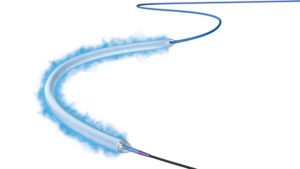
Boston Scientific announced it has received US Food and Drug Administration (FDA) approval of the Ranger drug-coated balloon (DCB), developed for the treatment of patients with peripheral arterial disease (PAD) in the superficial femoral artery (SFA) and proximal popliteal artery (PPA).
According to a press release, the Ranger DCB was designed with a low therapeutic drug dose and proprietary coating which efficiently transfers the drug into the tissue, resulting in high primary patency rates and low systemic drug exposure for patients.
“This approval allows us to bring more treatment options with exceptional outcomes and proven safety to US physicians and their patients who are facing this challenging disease,” said Jeff Mirviss, president, Peripheral Interventions, Boston Scientific. “Adding the Ranger DCB to our drug-eluting portfolio, which also includes our Eluvia drug-eluting vascular stent system, reinforces our commitment to providing differentiated technology with strong clinical evidence that supports data-driven treatment decisions for millions of patients suffering from PAD worldwide.”
The FDA approval is based on results from the RANGER II SFA pivotal trial, which evaluated the safety and effectiveness of the Ranger DCB versus standard percutaneous transluminal angioplasty (PTA) for the treatment of patients with PAD in the SFA and PPA. In the randomised controlled trial, both primary endpoints were met:
- The primary safety endpoint of 12-month freedom from major adverse events (MAE) was 94.1% for those treated with the Ranger DCB vs. 83.5% for standard PTA (Pnon-inferiority <0.0001).
- Additionally, patients who received therapy with the Ranger DCB had a significantly lower target lesion revascularisation rate—a component of MAE—of 5.5% in contrast to 16.5% observed with standard PTA (p=0.0011), substantially reducing a patient’s need for repeat procedures.
- The primary efficacy endpoint of 12-month binary primary patency—a measure of the target vessel remaining unobstructed—was 82.9% for the Ranger DCB and 66.3% for standard PTA (p=0.0017). Primary patency by Kaplan-Meier estimate was 89.8% for the Ranger DCB and 74% for PTA at 12 months (p=0.0005).
“The Ranger DCB eases deliverability for a wide range of lesion complexities via a low profile platform that is compatible with smaller diameter guidewires and has shown consistent results in multiple randomised controlled trials,” said Ravish Sachar, physician-in-chief for Heart and Vascular services at UNC Rex Hospital (Raleigh, USA) and principal investigator of the RANGER II SFA trial. “For physicians seeking to limit systemic drug loss without compromising outcomes, data demonstrate the Ranger DCB is a safe and effective treatment option.”
The Ranger DCB also demonstrated nearly 90% primary patency in the investigator-sponsored COMPARE trial—the first head-to-head prospective, randomised controlled trial to compare two different DCBs. In the trial, the Ranger DCB demonstrated a similar primary patency rate of 88.4% to that of the 89.4% observed with IN.PACT Admiral drug-coated balloon (Medtronic) by Kaplan-Meier estimate (p=0.81), with a significantly lower drug dose density (2µg/mm2 paclitaxel vs. 3.5µg/mm2 paclitaxel, respectively).
Boston Scientific expects to initiate a registry of the Ranger DCB and the Eluvia stent in the coming months to gather additional real-world evidence, which will add to the breadth of clinical data collected on these devices to date. The registry is expected to include five years of patient follow-up with an emphasis on enrolling patient populations who have been historically underrepresented in clinical trials studying treatments for PAD.
The company announced CE Mark for the Ranger DCB in 2014 and plans to immediately launch the device in the USA.











